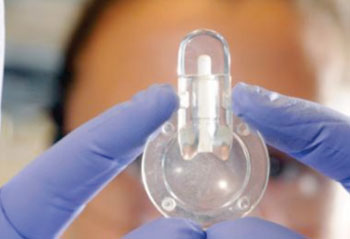Rapid Anemia Test Compares Favorably with Hospital Hemoglobin Analyzers
By LabMedica International staff writers
Posted on 23 Sep 2014
A prototype point-of-care testing device for anemia was evaluated and found to deliver results compatible with those obtained on a hospital hematology analyzer.Posted on 23 Sep 2014
Determination of anemia, a blood disorder that affects an estimated two billion people worldwide, is accomplished by measuring hemoglobin levels using hematology analyzers, which are housed in hospitals, clinics, or commercial laboratories and require skilled technicians to operate.

Image: Close-up of a prototype device for point-of-care testing of anemia. The device could enable more rapid diagnosis of the common blood disorder and allow inexpensive at-home self-monitoring of persons with chronic forms of the disease (Photo courtesy of Emory University).
Investigators at Emory University (Atlanta, GA, USA) have developed an inexpensive, disposable point-of-care device that allows rapid detection of anemia that does not require electrical power, additional equipment, or significant training.
The device analyzes a single droplet of blood (approximately five microliters) obtained from a finger prick using a chemical reagent that produces a visible color change that corresponds to different levels of anemia. The result is visibly readable in about 60 seconds and requires no electrical power. However, a companion smartphone application can be used to automatically correlate the visual result to a specific blood hemoglobin level.
The investigators verified the utility of the device by using it to test blood samples from 238 pediatric and adult patients with anemia of varying degrees and etiologies and compared the results to those obtained with a hospital laboratory hematology analyzer. The hemoglobin levels indicated by the device were estimated by visual interpretation using a color scale or by using an optional smartphone application to convert the color to a numerical result.
Hemoglobin levels obtained with the point-of-care device correlated well with those from the hematology analyzer (r = 0.864 and r = 0.856 for visual interpretation and smartphone application, respectively), and both point-of-care test methods yielded comparable sensitivity and specificity for detecting any degree of anemia.
"The test does not require a skilled technician or a draw of venous blood and you see the results immediately," said senior author Dr. Wilbur Lam, assistant professor of biomedical engineering at Emory University. "We think this is an empowering system, both for the general public and for our patients. Patients could use this device in a way that is very similar to how diabetics use glucose-monitoring devices, but this will be even simpler because this is a visual-based test that does not require an additional electrical device to analyze the results. Our goal is to get this device into patients' hands so they can diagnose and monitor anemia themselves."
The report was published in the August 26, 2014, online edition of the Journal of Clinical Investigation.
Related Links:
Emory University













